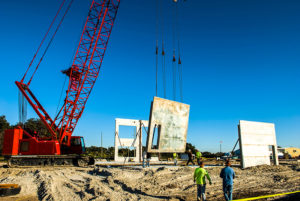Construction is an interesting and diverse industry. It’s also an extremely competitive one that both drives and relies heavily on a strong economy. While construction companies still do work in bear markets, those who get the most work and turn the most profit are also the ones who are able to deliver the most value for clients.
Knowing this, it’s vital for companies to keep a watchful and skeptical eye on the future, even while celebrating the times of plenty that currently exist. Being able to anticipate risk, maintain control, and improve performance is never an easy proposition.
A Diverse Technological Landscape Creates a Broadening Gap
Why? Because as mentioned, construction is extremely diverse—especially in technology adoption. Though many companies in this industry acknowledge the importance of technology for their business future, few have embraced it.
 This creates a problem and sets the stage for a widening gap where one portion of the industry still relies on paper-based reports and others strive to embrace and implement technology wherever possible. The broadening gap will create problems for those who fall behind. Even in good times, clients turn to organizations who can control costs and meet deadlines.
This creates a problem and sets the stage for a widening gap where one portion of the industry still relies on paper-based reports and others strive to embrace and implement technology wherever possible. The broadening gap will create problems for those who fall behind. Even in good times, clients turn to organizations who can control costs and meet deadlines.
But if and when times get rough? This competitive advantage turns into table stakes, and those who gain a reputation for letting things get out of control will be the first cut from the list of potential firms to work on a project. Therefore, it’s on leaders to understand where they are and take steps to fortify their business.
An Urgent, If Not Existential Crisis, According to KPMG
While companies labeled future-ready by KPMG have embraced disruption and have made investments in technology and innovation, others need to catch up. According to KPMG’s Future-Ready Index, a report built on interviews with leaders across the industry, the companies who can’t keep up face an “existential situation.”
“The remainder of the sector should, therefore, be asking themselves how they can elevate their game. Indeed, for those in the bottom 20 percent, the situation is considerably more urgent, if not existential. These companies face a race to go digital, to enhance their profitability and fend off competitive threats — including the possibility of takeovers.”
Future-Proofing Your Firm
Tomorrow’s construction firm will need to improve not only governance and controls, human capital, innovation, and technology, but integrate these functions to provide clients with an accurate quote and cost-effective project while increasing profits. Where should you begin?
Governance and Controls
Knowing that you have the right processes, ensuring they work, and consistently evaluating and improving them is critical to the success of both a project and the business. One of the most unique things in the construction industry is the sheer amount of moving parts that go into every single project, many of which are not under your direct control.
Varying capital requirements, strategic significance, and a combination of third parties and internal resources create a unique environment, and it’s necessary to see and control each and every part.
Leaders, according to the report, have taken on project management solutions that can help them control the project and meet schedules—nearly seven in ten of the top firms have implemented these systems. Compare this to the companies behind the curve—only 7% of whom use an integrated project management system—and the results are shocking: 66 percent of leaders see their projects run on schedule. None of the companies behind the curve do.
Technology Investments
You don’t need to implement robotics, AI, or AR just yet to be future-proof. It’s important, however, to develop a technological landscape that empowers you to leverage these. It’s expected that within 5 years, machine learning, cognitive machine learning and AI will be commonplace, and it’s important to set yourself up to use them.
Innovation does not just happen spontaneously, and those who can clear their path to succeed are able to embrace a variety of benefits including better, energy-efficient design, tighter scheduling, improved quality control, higher productivity and safer workplaces.
 Continued Focus on Human Performance
Continued Focus on Human Performance
Like many other sectors, engineering & construction is struggling to attract the right kind of people. Perhaps even more critically, organizations are now competing for skilled workers not just with each other, but with a wide range of employers from technology and other industries, as they seek to acquire and develop solid engineering and project management skills, along with the tech know-how to apply these capabilities in an increasingly digital environment.
To address this, those companies leading the charge are able to train their people, attract digital-native employees like Millennials and Gen Z, and reinforce ‘soft’ controls including training programs, formalized and communicated mission statements, project status updates, leadership development, conflict and bias programs.
Bringing It All Together: Integration Makes Construction Work
Another thing about these leading organizations? They know how to connect people, processes, and technologies to ensure that not only their projects, but their business as a whole moves forward.
As you focus on delivering profitable projects, you can’t afford delays, opacity, or misinformation, and you most certainly can’t afford to be tied to a legacy application that slows your business down. For those businesses looking to move from laggard to leader, the cloud provides this. Offering anytime, anywhere access, a single version of the truth, and workflows designed to make your projects more efficient and effective, cloud solutions like Acumatica for Construction are a logical step for companies like yours.
As a leading provider of this solution, Crestwood can help you implement and use this product to improve governance, set your business up for success, and deliver you on a path to future readiness. Let’s get in touch.
